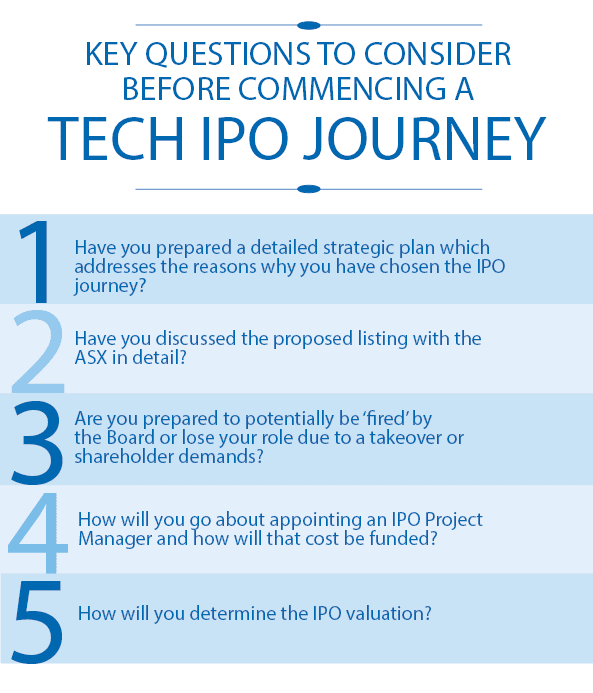Is an Initial Public Offering (“IPO”) right for you?
Assessing if an IPO is right for your tech company requires you to look into the future. You need to know where your business is heading (your vision) and the steps that will help get you there. In essence, it’s about having a blueprint that can explain your strategy.
Deciding to go public can be a great move for a company to grow but it’s not for everyone. Before making the decision, consider a few questions:
- Is an IPO in the best interests of the business and its shareholders? What are your motivations?
- Have you built in processes to handle growth and customer acquisition costs?
- What is the purpose of the listing? Are there other options available to the company?
Whether an IPO is included in the future of your business is dependent on many drivers, including:
- Access to capital markets for growth;
- Credibility;
- Publicity / visibility; and
- An exit event for existing shareholders.
Timing is also a critical factor. It could be when your company achieves certain milestones, i.e. revenue or EBITDA growth, or expands into new markets. Timing will always be dependent on the gyrations capital markets, industry dynamics and market appetite.
Going public can be expensive. IPO costs can add up, ranging between 2% to 10+% of funds raised and there’s no guarantee of success. You need to assess IPO costs in particular the overall cost of listing compared with the amount of funds to be raised. These costs include:
- Advisor costs including accounting, legal, underwriting/sponsoring broker costs;
- Board costs;
- PR;
- Initial listing costs;
- Ongoing compliance costs to meet Australian Securities Exchange (ASX) requirements; and
- Ongoing corporate governance costs due to heightened scrutiny from investors and/or media.
An IPO process can be complex and uncertain. If you have plans to go public, ensure you have a Plan B in the instance where the IPO is cancelled, put on hold or is unsuccessful. Your Plan B needs to enable the business to move forward in the pursuit of its strategy without any funding interruptions.
Learn from others – IPO successes and failures
While timing can be different for everyone, there are a few common traits of an IPO-ready company. Investors are attracted to business that are built to last, so founders that practice ‘good hygiene’ with areas such as cash flow management, governance and product roadmaps will stand out.
In our experience, the factors below can influence the IPO outcome.
- Is the proposed IPO capital raise required given the growth profile of your tech company? i.e. as an early stage tech company, investors will demand their capital be deployed in areas of the business which will drive growth and therefore shareholder value.
- The IPO valuation being over-priced, resulting in potential investors losing interest, as was recently seen with the high-profile WeWork IPO failure.
- Failure to have early engagement with the ASX to sound out whether ASX is on-board with the proposed IPO and whether listing requirements will be satisfied.
- Prior to listing, a company must plan and understand the potential reporting and tax implications from issues including:
- In which country will profits arise?
- Where will operations be controlled from?
- Will the company be providing employees with shares or options?
- What does the future corporate structure look like?
Other considerations you need to be aware of:
- Becoming a listed company may distract management from executing the strategic plan. If your public company comes under scrutiny from investors and/or the media, this may hamper business growth.
- Founder CEOs need to properly consider whether they are willing and able to pivot/transform their Management style to embrace the additional responsibilities and pressures associated with a listed company. Founder CEOs need to be aware of the risk of being ‘turfed’ from their role by either the Board of Directors or due to shareholder pressure if the business is not performing in accordance with expectations, resulting in having minimal control over an entity in which they would likely hold a significant amount of equity.
- Undertaking an IPO for the wrong reasons, for example prestige of having a listed company.
- An IPO with thinly-traded shares, usually as a result of founder shareholder/s trying to retain controlling stakes greater than 50%, resulting in low volumes of shares traded and a market price that may not necessarily reflect the company’s value.
You’ve decided to go public – what next?
The lead up process for an IPO can be extensive. Being prepared early will make a difference as some of the requirements can take 12 – 15 months to complete. Below we’ve outlined areas and issues to be aware of.
Start compiling a data room
Collate and store in one secure electronic space all business agreements including lease agreements, supplier agreements, employment contracts, employee share option plans, customer MSA’s, etc. Once collated, review the agreements to identify potential issues which can be rectified well ahead of the IPO date.
Where necessary, you will need to work with your lawyer to make any updates or changes. Organising these documents will make the IPO due diligence process far easier and quicker when it’s ‘go time’.
Appoint an IPO Project Manager
An IPO Project Manager should be appointed to drive and own the IPO process. This person will be responsible for coordinating and engaging the various specialists (Auditor, Lead Manager, Investigating Accountant, Legal Advisor, Graphic Designer, etc.). This is preferably a person who is not currently involved in the business and has experience in successfully listing tech companies. The IPO Project Manager will need to get up to speed on the business quickly, particularly with respect to the strategic business plan.
The appointment of an IPO Project Manager will let the CEO continue to focus on execution of the business plan instead of being consumed by the IPO process.
Appoint a Lead Manager and Obtain an IPO Valuation
A Lead Manager for the IPO will need to be appointed to handle the book build. To achieve a successful tech IPO, it’s strongly recommended that you select a Lead Manager that has a network of tech-focused investors, with a strong track record of raising funds for tech IPOs.
The price for the offer (i.e. the implied valuation) is a key aspect of an IPO. The price should be determined in conjunction with the appointed Lead Manager and the commissioning of an Independent Valuation may also provide useful insights. Current market conditions should also be considered.
It can often be a good idea to undertake a pre-IPO capital raise (with the Lead Manager) at a discount to the proposed IPO valuation, in order to not only attract shareholders that you would like on the share register, but also test the appetite of investors to the determined IPO valuation.
Equity features such as spread, escrow and whether the capital raise is underwritten will also need to be determined as part of the IPO process.
Help investors understand ‘Use of Funds’
The Australian Securities and Investments Commission (ASIC) and ASX will want to understand in detail the ‘Use of Funds’ associated with a capital raising in connection with an IPO. There needs to be a detailed plan underlying the Source and Use of Funds (ideally part of the Strategic Plan discussed above), a summary of which will ultimately be presented to potential investors in the Prospectus.
A key challenge is achieving a balance in the Prospectus document between disclosing enough information on the ‘Use of Funds’ so that investors can understand how the funds are being utilised, and not ‘giving the game away’ to competitors.
Assemble your board & implement governance
In order to mitigate potential compliance issues once listed, companies will need to think about the formulation of a Board during the IPO process. The Board will need to be appropriately sized and cover the skills required from both an operational, strategic and governance perspective.
The appointment of a reputable auditor is also crucial. In selecting an auditor, a company embarking on an IPO needs to look for an auditor who is not only appropriate for preparing the audited financials needed for the IPO but is also a good fit for the ongoing audit role post-listing in order to maintain continuity.
Preparation and Lodgement of Prospectus
To complete a successful listing, a Prospectus must be prepared, lodged and approved by both ASIC and the ASX. This process involves the formulation of a due diligence committee, which is typically comprised of an investigating accountant, legal advisor, the lead manager and members of the Board.
William Buck are experienced in assisting tech businesses embark on the journey to IPO and are able to assist with respect to strategic planning, tax structuring, audit, investigating accountant role and due diligence committee role.

Insight tips from our Experts






































